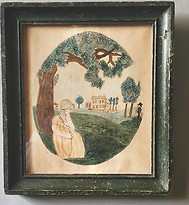19th century folk art and watercolors on paper.
- Randi Ona
- Feb 20, 2024
- 2 min read
Updated: Oct 14, 2025
Careful conservation and display techniques will ensure that you get pleasure from your early watercolors for years to come.
Early watercolors were usually on parchment made of linen rags and cellulose (an insoluable substance of plant cell walls and vegetable fibers) making them more resilient to deterioration. From the 1840s onwards, paper was made from wood pulp and acidic chemicals. These additives contributed to the paper turning brown and brittle that led to foxing. While these vulnerabilities cannot be completely avoided, there are techniques that will help to avoid decaying of the paper and pigments.
Frames should be secure, sealing gaps to prevent openings for dust, contaminants, and insects. Old framed pieces should be checked for signs of acidic decay. Backing boards and mounts made from acidic materials can lead to damage and the appearance of brown marks on the artwork. Paper absorbs moisture from the atmosphere and may weaken the tissue fibers. Mold and foxing are also exacerbated by increased humidity. Very low humidity from direct sources of heat such as radiators, hot air vents, and fireplaces can also be a problem, as this can cause the paper to become dark, yellow, and brittle.
Any work of art should not be displayed in direct sunlight; early watercolors are particularly fragile. Even a few weeks in direct sunlight or in a very bright room with reflected light can fade the pigments and make the paper brittle, bleached, or yellowed. Clear glass does provide some protection to works on paper, but it still allows harmful ultraviolet rays to filter through. Ultraviolet filtering glass blocks most ultraviolet light and protects the watercolor from becoming brittle and faded. The glass should not be in direct contact with the paper, as the glass may stick to the paper and deteriorate the pigments in contact with the glass. Placing spacers between the glass and the paper will avoid this damage.
Taking these steps to protect and preserve your watercolor will help ensure years of enjoyment.










Comments